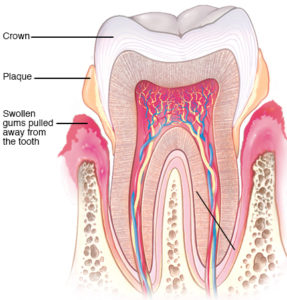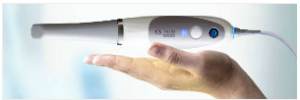Header logo
header top contact widget
Periodontitis
A Dry Mouth Can Have Many Causes And Lead To A Number Of Oral Health Problems
Posted on Jun 21, 2019 by William J. Claiborne, DDS MS
Our lips and teeth – our smile – is a stage curtain to what is actually going on inside the mouth. As an Asheville periodontist, I have a daily view of the hazards that exist beyond the veil.
Oral bacteria is the root source of most problems that occur in the mouth. Their presence is normal, of course. The mouth (or “oral cavity”) is designed to be able to manage a certain level of oral bacteria. It is the over-accumulation of this bacteria that is the origination source of many problems.
Although certain foods, such as a garlicky shrimp or onion-laden hot dogs, can create “stand-offish” bad breath, this breath odor is temporary. The bad breath that is truly offensive and occurs on a more consistent basis comes from an overload of oral bacteria.
The reason we’re advised to brush at least twice a day and floss our teeth daily is to remove accumulated oral bacteria from the mouth. When not removed on a regular basis, the bacteria form a sticky film that coats the teeth and gums. This film is known as plaque.
Keep in mind that bacteria are living, eating, and reproducing organisms. Because they eat, they also create waste – in our mouths! Although that in itself should be reason enough to be committed to brushing and flossing, without pain, people assume that all is well.
Yet, an over-accumulation of oral bacteria can lead to far worse than bad breath. Because oral bacteria critters eat, they look to the gum tissues. As they amass, they can create an inflammation that extends beneath the gum line. The infection they trigger can reach down into the structures that support natural teeth.
Periodontal disease is the leading cause of adult tooth loss. The advanced stage of gum disease, known as periodontitis, creates a bacteria so potent that it has been linked to a wide array of conditions and diseases elsewhere in the body.
The oral bacteria of advanced-stage gum disease has been associated with some cancers, heart disease, stroke, Alzheimer’s disease, diabetes, arthritis, preterm babies, and impotency. As research continues, more and more health problems are being correlated to this bacteria.
The saliva in the mouth is designed to move bacteria out. Twice daily brushing and flossing help. However, certain contributing factors complicate the ability to keep oral bacteria levels to manageable levels. These include:
• Colas/Sodas: Not only is the acidity level in these drinks harmful to tooth enamel, it can make oral tissue to dry out. Downing these beverages because you feel you are replenishing moisture is the last thing they do; refreshing they are not. Drink plain, filtered water instead. It’s much better for your mouth and hydrating to the entire body.
• Coffee/Tea: Like colas, these drinks contain acid added to caffeine. Even green tea often contains caffeine. Caffeine has a drying effect on oral tissues and therefore depletes the helpful rinsing benefits or saliva.
• Alcohol (including beer and wine): Mixed drinks, “shots,” wine and even beer are all drying to oral tissues. Add the acidity and sugar levels that exist in wine or mixers and these drinks pack a double-whammy to oral tissues. If you imbibe, alter your drink with a glass of water in-between to neutralize acids and wash sugars from the mouth.
• Smoking (cigarettes, cigars, vaping, cannabis): People who have smoked for years often have dry skin that has an aged appearance far beyond their actual years. The same is occurring inside the mouth. The smoke of cigarettes and cigars is laden with toxic chemicals; true for e-cigs as well. Vaping doesn’t keep your mouth much safer than cigarettes. Even marijuana has been found to have a negative impact on oral tissues.
• Aging: Through aging, our skin, cartilage, and tissues are less supple. Our bodies simply dry out more and more with each decade. Although there’s nothing we can do to halt the aging process, we can take measures to minimize the damage to our oral health. We recommend drinking plenty of water throughout the day, using an oral rinse designed to replenish moisture in the mouth, and limit sugar and caffeine.
As a periodontist, I also urge people to be familiar with the signs and symptoms of periodontal disease, which begins with gingivitis. In this early-stage of gum disease, the gums may feel tender and swollen in one area. You may notice some bleeding when brushing your teeth. Your breath may feel less-than-fresh more often. However, some people experience no symptoms at all at this early stage.
If not treated, gingivitis can progress to periodontal disease, where symptoms are more obvious. The gum tissues are sore and bleed easily when brushing. Your breath will be bad more frequently. The gum tissues may swell in some areas and turn red.
As gum disease advances, the gums can begin to pull away from their tight grip around the base of some teeth, exposing darker, more sensitive areas of the tooth’s root. The gums will ache often and pus pockets may form at the base of some teeth. The breath is foul, even after brushing. And, tooth brushing is very uncomfortable with blood in the sink each time.
Eventually, the disease will have penetrated the supportive bone and ligaments that support teeth. In advanced cases, the teeth will begin to move and some may require removal.
All of this devastation to the mouth can be avoided, however. When people respond to early signs of gum disease by seeing a periodontal specialist, they can avoid the time and expense required. In addition to preventing the loss of natural teeth,

Enjoy beautiful, relaxing views from our surgical suite.
research now shows that serious health problems far beyond the body can be avoided as well.
If you have delayed or avoided dental care, begin with a consultation to learn about your options to have a healthy smile that is worry-free. Regardless of your love of coffee, your smoking habit, or your age, we can develop a program that allows you to have good oral health.
Begin by calling 828-274-9440 to request a consultation, or begin with a thorough examination in our Asheville periodontal office. We offer the latest techniques, technology, and skills while always putting patient comfort at the top of the list!
How You Develop Gum Disease, And How To Avoid It.
Posted on May 29, 2019 by William J. Claiborne, DDS MS
Other than a canker sore or bite on the cheek, almost no problem in the mouth will clear up on its own. This is often because the symptoms of most oral problems don’t emerge until they are well-developed.
For example, a cavity typically doesn’t become obvious until it begins to ache. Once it causes discomfort, it is a well-established problem. It won’t repair itself, and will eventually worsen (and become even more painful) to the extent where removal becomes necessary.
As a Periodontist, I often see people who have developed periodontal disease who come (or have been referred) because they are enduring obvious problems. However, I also see patients who are surprised to learn they have developed the disease. Yet, even without obvious symptoms, gum disease may exist and be fully underway.

Signs of gum disease
For some people, warning signs are ignored. Some simply don’t associate bad breath or bleeding gums with a disease of the mouth. As a matter of fact, I see may people who first arrive and proudly claim they do such a good job brushing their teeth, they spit blood in the sink.
Let’s use this time together to understand how gum disease forms and the symptoms associated with it. The typical process of how gum disease begins and progresses is:
1. Accumulation Of Oral Bacteria – We all have bacteria in our mouths. This warm, moist environment takes in an enormous amount of bacteria-laden items. Bacteria is on our food, utensils, the glass we drink from and the pencil we hold between our teeth. Of course, bacteria cannot be prevented altogether. However, the problem begins when too much bacteria accumulate.
2. Plaque Forms – Without proper brushing, flossing, saliva flow and diet, oral bacteria can reproduce rapidly. Their accumulation over the course of a day forms a sticky film you feel on teeth. This is known as plaque.
3. Development of Calculus – In just 48 hours, unremoved calculus, also known as tartar, can harden onto teeth. This is actually a cement-hard colony of oral bacteria. Like plaque, calculus will continually reproduce and grow as the bacteria feed on tooth enamel and tender gum tissues.
4. Initial Stage Gingivitis – This is actually the first stage of gum disease. At this level, gum tissues are under attack and become sore. They may bleed easily when brushing and you may experience an aching sensation in some areas. Your breath will no longer feel fresh. At this point, with proper measures, you can restore your gums to a healthy state. However, there is a fine line between being able to undo gingivitis and its progression to gum disease.
5. Periodontal (Gum) Disease – At this level, the gums are inflamed and tender. You may notice them darken in color and begin to pull away from the base of some teeth. You’ll have persistent bad breath.
6. Advanced Gum Disease – When gum disease progresses to periodontitis, your breath odor is persistently offensive. Bacteria-filled pus pockets may form on gum tissues near the base of some teeth. Chewing becomes painful and teeth can loosen, eventually requiring removal.
There are various stages of periodontitis. The Mayo Clinic does an excellent job explaining these advanced-stage levels (https://www.mayoclinic.org/diseases-conditions/periodontitis/symptoms-causes/syc-20354473):
- Chronic periodontitis is the most common type, affecting mostly adults, though children can be affected, too. This type is caused by plaque buildup and involves slow deterioration that may improve and get worse over time but causes destruction in the gums and bone and loss of teeth if not treated.
- Aggressive periodontitis usually begins in childhood or early adulthood and affects only a small number of people. It tends to affect families and causes rapid progression of bone and tooth loss if untreated.
- Necrotizing periodontal disease is characterized by the death of gum tissue, tooth ligaments and supporting bone caused by lack of blood supply (necrosis), resulting in severe infection. This type generally occurs in people with a suppressed immune system — such as from HIV infection, cancer treatment or other causes — and malnutrition.
Nearly half of American adults have some level of gum disease. Sadly, it is the nation’s leading cause of adult tooth loss. Yet, it’s one of the most preventable diseases with simple measures.
Twice daily brushing (at least two minutes per time), daily flossing, drinking ample water and limiting sweets and caffeine are simple ways to keep your mouth healthy between regular dental check-ups and cleanings. And, those 6-month check-ups are important. At this time, any tartar that has accumulated can be removed and signs of early gum disease can be noted.
Imagine losing your teeth and having to decide on a crown-&-bridge combination, partial, full denture or Dental Implants. These procedures and expenses can be avoided. And, contrary to what many believe, losing teeth is not a natural part of the aging process. With proper care, you can easily enjoy a smile of natural teeth all your life.
If you are experiencing symptoms of gum disease, call 828-274-9440. We’ll restore your oral wellness and develop a program to help you keep it at its best.
Bad Breath? That May Be The Least Of Your Problems!
Posted on May 23, 2019 by William J. Claiborne, DDS MS
We’ve all run into people who have bad breath. Although a tuna salad lunch or onion-laden hot dog can cause folks to pull back from close-up conversations, these forms of bad breath are temporary.
 The smelly breath odor that is more concerning is that which comes from the sticky film of bacteria that coats the mouth and emits sulfuric odors (likened to rotten eggs). This film, known as plaque, coats the teeth and gums when allowed to build up.
The smelly breath odor that is more concerning is that which comes from the sticky film of bacteria that coats the mouth and emits sulfuric odors (likened to rotten eggs). This film, known as plaque, coats the teeth and gums when allowed to build up.
For example, the reason you wake up with not-so-fresh breath in the morning is the result of the mouth being closed all night while bacteria reproduces and accumulates. Without brushing and due to declined saliva flow (your mouth’s natural rinsing agent) during sleep, oral bacteria amass. Thus, you wake up with the sticky film and the breath that goes with it.
For those who are mouth-breathers during sleep or who snore, dry oral tissues allow for even more bacterial growth.
Once you brush and rinse thoroughly, however, you can expect your breath to become more pleasant. Persistent bad breath, however, may be the a side effect of medication, an illness, or periodontal (gum) disease.
As a periodontal specialist, I’m very much aware of the distinct odor produced by gum disease. Although it varies slightly from person to person, it has an offensive scent than that of typical bad breath.
The best way to determine gum disease as the true source is through a periodontal exam. In addition to persistent bad breath, periodontal disease symptoms include gum tenderness, gums that bleed when brushing, and gums that are red in color rather than a healthy pink. Early stage gum disease (gingivitis) may not cause any obvious symptoms, however.
Regardless of the source of unpleasant breath odor, it is imperative to have and maintain good oral health – for reasons that can impact your overall health. Through decades of research and studies, the bacteria of gum disease has been linked to serious health problems, including heart disease, stroke, arthritis, diabetes, impotency and some cancers.
For example, rheumatoid arthritis (RA) and pneumonia are just two diseases that have a connection to gum disease. Researchers have found that RA sufferers have a higher incidence of periodontal (gum) disease compared to individuals with a healthy oral condition.
Studies have also shown that RA patients are nearly 8 times more likely to have gum disease. Although insufficient oral hygiene can certainly be a determining factor in acquiring gum disease, other parameters point to a deeper association between RA and gum disease.
Because both RA and gum disease both cause internal inflammation, a connection between the two are most prevalent when examining the joints and oral tissues. Oral tissues with the presence of periodontitis compared to tissues of RA-affected joints show a number of similarities. Research has also discovered a genetic link between the two.
And the health threats go further. One study published by Science Daily found that the bacteria present in the mouth can release toxins that can make their way into the brain. (https://www.sciencedaily.com/releases/2019/01/190123165002.htm)
Once there, they may contribute to Alzheimer’s disease. While studies on this connection continue, other studies have found a clear path of triggers traced to the inflammatory reactions caused by the bacteria of gum disease.
Once periodontal disease is established in the mouth, its pathological byproducts can enter the bloodstream, lymph fluid, and bone structures. This can lead to the spread of infection and inflammation to all areas of the body. In this way, periodontal disease has been shown to be a cause of systemic disease.
While fresh breath and a gleaming smile are important, it’s clear that oral wellness plays a leading role in helping you avoid serious, and even deadly, health conditions.
If you’re experiencing any of the symptoms of gum disease mentioned above or are past due for a dental exam, call our Asheville periodontal office at 828-274-7440. If desired, you can begin with a private consultation, where we will discuss your symptoms and health history. During this time, I’ll answer your questions, explain treatment options and discuss comfort methods.
Asheville Periodontic Specialty Office Offers Latest To Enhance Treatment Outcomes, Comfort.
Posted on May 13, 2019 by William J. Claiborne, DDS MS
As an Asheville NC periodontist, I know it is more than my specialized skills that keep us busy. Many dentists and other dental specialists refer patients to our office because they know each patient receives optimal care with a gentle, respectful touch.
Another thing we are known for is the state-of-the-art technology we use to save patients time while they achieve the very best results in minimal treatment time. Some of our advanced features available include:
LANAP Protocol Using PerioLase MVP-7 – An acronym for Laser-Assisted New Attachment Procedure, LANAP provides an advanced protocol to more efficiently and effectively treat periodontitis (advanced gum disease) with the PerioLase® MVP-7™ laser. This offers a minimally invasive (non-surgical) treatment alternative for patients with moderate to severe periodontal disease.LANAP treatment leaves very little discomfort and has a quick recovery time. It has also been found to stimulate bone regrowth in damaged areas.
Dental Radiology With 3-D Cone Beam Technology – We rely on 3D imaging in diagnostic and treatment planning. This latest level of 3D imaging covers the whole dentition area, giving a clear view of the mandible and maxilla (upper and lower jaw) for intricate review for the diagnostic requirements of endodontics, periodontics, orthodontics, implantology, TMJ and prosthodontics as well as dental and maxillofacial surgery.
In addition to imaging, cone beam radiographs provide images in sagittal, axial, and coronal planes. This makes it possible to locate and trace the mandibular nerve canal for pre-surgical planning for an ideal implant position.
We also like that our patients are exposed to only minute levels of radiation through a process that is fast and comfortable.
CareStream Cone Beam Computer Tomography Imaging – Our office features the Carestream 9300. This Cone Beam Computer Tomography provides dual modality panoramic and 3D imaging with exceptional detail and range. The CS 9300 can deliver 3D imaging at a significantly lower dose than 2D panoramic imaging. In fact, in a recent study, the CS 9300 and CS 9300 had up to an 85% lower radiation dose than traditional panoramic imaging.

Carestream 3600
CS 3600 intraoral scanner – No longer do our patients have impressions made with bulky, goopy trays held in their mouths!
The CS 3600 Scanner is designed to quickly and comfortably scan areas inside our patient’s mouth. It acquires digital impressions accurately and easily, scanning a full or dual arch for the fabrication of digital models or appliances.
The CS 3600 provides a highly accurate digital impression using a small, handheld scanner. It can also reach difficult–to–access areas in the patient’s mouth for superior results with improved patient comfort.
Just some of the superior features of the CS 3600 Scanner include:
• Acquires digital impressions to design crowns, inlays, onlays, bridges, orthodontic appliances and aligners, custom abutments and RPD;
• Has an Intelligent Matching System that prevents missing data in any area. Plus, it even sends a warning to indicate areas of the scan that lack detail;
• Has adaptive hole filling that automatically identifies holes and selects the appropriate anatomical color for optimal aesthetic outcomes;
• Enhances outcomes for restorations, orthodontics and implants; and,
• Displays precise, accurate HD 3D color images with vivid color and details for improved case review, analysis and communication between doctors, referrals and labs.
Simplant Dental Software for Computerized Dental Implant Placement – This advanced software system allows for pre-surgical positioning of dental implants on the computer using a 3D model of the patient’s jaw. Once the implant type is selected, a surgical template is developed that ensures a precision fit. Simplant creates optimal implant treatment success, even for complex cases. It also simplifies the team treatment process so intricate aspects of the surgical process can be discussed prior to placement.
Intraoral Camera Technology – This self-contained intraoral camera features full motion video with outstanding image quality from an internal camera that captures ideal angles and images with the click of a button. The images are sent to screen for a clear, crisp view so we can confer with patients on specific treatment issues.
Computer Imaging In Treatment Suites – Treatment suites are equipped with computers for convenient image sharing with patients. This allows patients to have a more complete understanding of their individual needs through images that can be pulled up by our dental team, with the ability to enlarge certain areas to show specific details. Through this, patients have greater involvement in treatment decisions.
Advanced Sterilization – Our custom sterilization unit is designed to adhere to or exceed established Centers For Disease Control & Prevention (CDC) guidelines for instrument processing protocols. Intuitive colored lighting identifies the receiving and cleaning of instruments.
Fully-Equipped Surgical Suites – Relax during treatment (under sedation, if desired) while you are surrounded with the serene views surrounding our Asheville periodontal office.
So you see, we are committed to providing each patient with advanced skills, experience, comfort, and technology that provides the very best in periodontal and dental implant treatment available.
If you have experienced periodontal (gum) disease or are considering gum recontouring or tooth replacement with dental implants, being referred is not always needed. Call our friendly staff to discuss your needs: 828-274-9440.
Recent Posts
Categories
Archives
- September 2024
- August 2024
- July 2024
- June 2024
- May 2024
- April 2024
- March 2024
- February 2024
- January 2024
- December 2023
- November 2023
- October 2023
- September 2023
- August 2023
- July 2023
- June 2023
- May 2023
- April 2023
- March 2023
- February 2023
- January 2023
- December 2022
- November 2022
- October 2022
- September 2022
- August 2022
- July 2022
- June 2022
- May 2022
- April 2022
- March 2022
- February 2022
- January 2022
- December 2021
- November 2021
- October 2021
- September 2021
- August 2021
- July 2021
- June 2021
- May 2021
- April 2021
- March 2021
- February 2021
- January 2021
- December 2020
- November 2020
- October 2020
- September 2020
- August 2020
- July 2020
- June 2020
- May 2020
- April 2020
- March 2020
- February 2020
- January 2020
- December 2019
- November 2019
- October 2019
- September 2019
- August 2019
- July 2019
- June 2019
- May 2019
- April 2019
- March 2019
- February 2019
- January 2019
- December 2018
- November 2018
- October 2018
- September 2018
- August 2018
- July 2018
- June 2018
- May 2018
- April 2018
- March 2018
- February 2018
- January 2018
- December 2017
- November 2017
- October 2017
- September 2017
- August 2017
- July 2017
- June 2017
- May 2017
- April 2017
- March 2017
- February 2017
- January 2017
- December 2016
- November 2016
- October 2016
- September 2016
- August 2016
- July 2016
- June 2016
- May 2016
- April 2016
- March 2016
- February 2016
- January 2016
- December 2015
- November 2015
- October 2015
- September 2015
- August 2015
- July 2015
- June 2015
- May 2015
- April 2015
- March 2015
- February 2015
- January 2015
- December 2014
- November 2014
- October 2014
- September 2014
- August 2014
- July 2014
- June 2014
- May 2014
- April 2014
- March 2014
- February 2014
- January 2014
- December 2013
- November 2013
- October 2013
- September 2013
- August 2013
- July 2013
- June 2013
- May 2013
- April 2013
- March 2013
- February 2013
- January 2013
- December 2012
- November 2012
- October 2012
- September 2012
- August 2012
- July 2012
- June 2012


